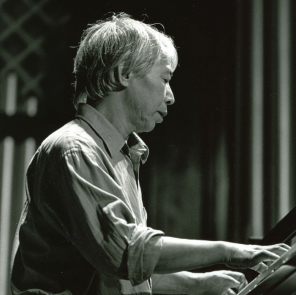The Shibuya Takeshi Orchestra, one of the most unique, difficult and unusual groups of Tokyo jazz is. Many jazz groups strive to master technique. They push their instruments to the limit of fast-fire playing and perfect one style. The Shibuya Takeshi Orchestra is a joyous, wild style of collective jamming, which enjoys contradiction. Takeshi Shibuya, the Orchestra’s keyboard player, is the main influence behind the unique jazz concept. Since 1986, the nine-member Orchestra has been performing regularly in Tokyo. They have recorded five CDs and their underground reputation is only just beginning to gain wider recognition. The majority of the members are now in charge of their own satellite bands and perform regularly around town. Shibuya’s leadership has allowed the orchestra to take a more energetic, rough approach than the jazz world. Shibuya, in contrast to the band’s intensity is calm and collected during conversation. He sat down over tea to discuss his answers, and he seemed to think about the implications of even the most simple questions. He simply answered the question about the size of the group by saying, “When I started listening to jazz, the West Coast sound of people such as Quincy Jones or Shorty Rogers was my favorite.” He said that they had such a large group. It is hard to distinguish between West coast jazz’s smooth style and the Orchestra’s more raucous sound. He smiled and said, “I just like its size.” He waved his hands in a gesture of reorientation when questioned about his leadership. “As a leader I don’t ask anyone for any sound. This is not my sound. He replied, “It’s just fun.” Shibuya’s casual, relaxed manner clearly reflects a flexible and loose vibe. He said, in typical understatement, “There is no plan exactly.” But, he added, “But the relationship is good.” Everyone can do whatever they want once the energy flows. There are many tricks to keep the energy flowing. He is known for finishing sets late and starting them late. He also likes to lay out in the middle songs and smoke while listening. Orchestra shows up to live shows with no set list. The Orchestra will undoubtedly call out unexpected tunes during the show. This forces the front line to search through their large music collection for the correct lead sheet. Although this confusion is amusing for everyone, the front line must also laugh. All songs have clear melodies and turn taking soloing, just like traditional bands. But they don’t have much time to prepare so they must rush to be ready. They are able to keep each other out of harm’s way, and they know how to fill empty slots. However, they cannot rely on their practiced phrases. The result is a raw and unrefined sound. Their arrangement of the “Cherokee”, a traditional song, is not like any other bebop arrangement. The melody is left in the hands AkihiroIshiwatari’s unusually fast guitar. Front line horns pump out a web filled with back riffs, overlapping lines and other sounds. The members of “Ballad” hover just above satire and are not willing to succumb to traditional sentimentality of ballad form. The members fill the tune with irony and humor, rather than the usual mournful sadness. Eiichi Hayashi, a saxophonist, plays “Brother” to the fast, driving beat of Ryojiro Furusawa’s drums and Katsumasa Kamimura’s funky bass. The fast tempo means that the solos of “Brother”, despite being a fast-paced piece, are often the most free. Hayashi and Kenta Tsugami’s sax go far beyond the melody, and even to the edge, which is a sign of the freedom of the music. Although they draw from both modern and traditional styles, the Orchestra does so with a playful sense of appropriation and juxtaposition. He said, “The Orchestra takes an old shuffle beat and adds free jazz to create a new mix.” The Orchestra doesn’t view all these influences as models that can be copied. Instead, they focus on the core of the styles and then create new ones. The Orchestra believes that Ellington, West Coast Jazz, Dixieland and free jazz are not forms that can be copied, but rather processes to explore. Their experiments have had mixed results. Sometimes the Orchestra can fall into repetitive vamps or high-energy solos without direction. Sometimes, the Orchestra can sound like an over-agitated rehearsal if a few members don’t click with a song. It’s evident that Shibuya and many Orchestra fans are prepared to endure a few awkward passages in order to reach the highs. The best music is fast-flowing and filled with an ironic sense cool. It’s more than just about pushing the limits and doing cathartic blowing. Shibuya is a regular returnee to music that has been carefully considered in terms of musical and emotional depth. Shibuya’s 1999 solo project, “Essential Ellington”, was released. The recording featured his piano and a trio consisting of two saxes (played by Orchestra regulars Kosuke Mine u0026 Koichi Matsukaze) and a tuba (played by Takero Sekijima). To uncover new resonances in Ellington’s classics, the arrangements re-align harmony and melody among all four instruments. The idiomatic and rich reading of Ellington’s classics by the re-readings is beautiful, stately, and lush. Ellington’s concept was always appealing to me. He is always playful and he turns things around. He said that his arrangements are always complex and reminiscent of free jazz, which made another surprising connection. Shibuya has been accompanied by singers for the past few years and recorded a series introspective duets with some of Tokyo’s finest musicians. He also ends Orchestra shows with a solo piano performance. It is striking to see the contrast between the unrestrained sound of the orchestra’s nine-piece ensemble and the serene, reflective beauty of Shibuya’s “Lotus Blossom,” which was written by Billy Strayhorn for Ellington. This reminds the audience that there are always contradictions. from jazzinjapan.com
